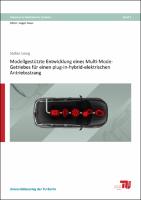Modellgestützte Entwicklung eines Multi-Mode-Getriebes für einen plug-in-hybrid-elektrischen Antriebsstrang
| dc.contributor.author | Geng, Stefan | |
| dc.date.accessioned | 2023-04-04T10:04:58Z | |
| dc.date.available | 2023-04-04T10:04:58Z | |
| dc.date.issued | 2023 | |
| dc.identifier | ONIX_20230404_9783798332997_7 | |
| dc.identifier.issn | 2702-119X | |
| dc.identifier.uri | https://library.oapen.org/handle/20.500.12657/62255 | |
| dc.language | German | |
| dc.relation.ispartofseries | Advances in Mechatronic Systems | |
| dc.subject.classification | thema EDItEUR::T Technology, Engineering, Agriculture, Industrial processes::TG Mechanical engineering and materials | en_US |
| dc.subject.classification | thema EDItEUR::T Technology, Engineering, Agriculture, Industrial processes::TH Energy technology and engineering | en_US |
| dc.subject.other | powertrain simulation | |
| dc.subject.other | powertrain optimization | |
| dc.subject.other | multi-mode-transmission | |
| dc.subject.other | operating strategies | |
| dc.subject.other | hybrid electric vehicles | |
| dc.title | Modellgestützte Entwicklung eines Multi-Mode-Getriebes für einen plug-in-hybrid-elektrischen Antriebsstrang | |
| dc.type | book | |
| oapen.abstract.otherlanguage | Plug-in hybrid electric vehicles combine low-emission driving with the advantages of conventional powered vehicles in terms of operating range and refueling time. Decisive for the fuel economy of such vehicles is the configuration of the transmission, the internal combustion engine and the electric motor within the powertrain. Powertrain configurations with multimode transmissions can switch between various couplings of the engine and electric motor, enabling additional fuel savings compared to a fixed coupling. This thesis describes a systematic approach for the model-based development of multimode transmissions and the corresponding control algorithms. It is based on a modelling approach for powertrains and transmissions, while the model's level of detail can be adapted to various development tasks. The overall approach is used to develop a functional concept that provides the basis for the design of a new multimode transmission. For this transmission the necessary control algorithms and an operating strategy for selecting the gear and operating mode are developed. Furthermore, a model-based evaluation of the potential fuel consumption is carried out, taken into account efficiency measurements obtained from a corresponding transmission prototype. | |
| oapen.identifier.doi | 10.14279/depositonce-16734 | |
| oapen.relation.isPublishedBy | e5e3d993-eb32-46aa-8ee9-b5f168659224 | |
| oapen.relation.isbn | 9783798332997 | |
| oapen.relation.isbn | 9783798333000 | |
| oapen.collection | AG Universitätsverlage | |
| oapen.series.number | 2 | |
| oapen.pages | 264 | |
| oapen.place.publication | Berlin |

